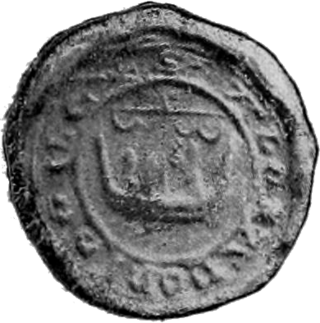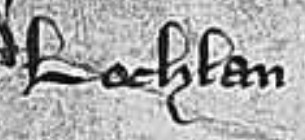
Eóghan MacDubhghaill was a 13th-century Scottish nobleman and warrior who was styled "King of the Isles", "Lord of Argyll". He was the son of Donnchadh, son of Dubhghall, son of Somhairle mac Gille Brighde.

Aonghus Óg Mac Domhnaill, or Angus Og MacDonald, was a fourteenth-century Scottish magnate and chief of Clann Domhnaill. He was a younger son of Aonghus Mór mac Domhnaill, Lord of Islay. After the latter's apparent death, the chiefship of the kindred was assumed by Aonghus Óg's elder brother, Alasdair Óg Mac Domhnaill.
Dubgall mac Somairle was an apparent King of the Isles. He was a son of Somairle mac Gilla Brigte and Ragnhildr Óláfsdóttir. Dubgall was a leading figure of Clann Somairle, and the eponymous ancestor of Clann Dubgaill. Dubgall's career is obscure, and little is certain of his life.
Donnchadh of Argyll or Donnchadh mac Dubhghaill was a late 12th and early 13th century Scottish noble. He was the son of Dubhghall mac Somhairle, son of Somhairle mac Gille Bhrighde. He is the first of the MacDougall lords of Argyll to take the title de Argadia, and can be regarded as the founder of the successful MacDougall lordship of Argyll. He was also a prominent builder, notable for his construction of Ardchattan Priory and Dunstaffnage Castle.

Aonghus Mór mac Domhnaill was a leading figure in the thirteenth-century kingdoms of the Isles and Scotland. He was a son of Domhnall mac Raghnaill, the eponym of Clann Domhnaill, a branch of Clann Somhairle. Aonghus Mór appears to have succeeded his father in the mid part of the thirteenth century. At the time, the rulers of the Isles were fiercely independent of the Scottish Crown, and owed nominal allegiance to the distant Norwegian Crown. Aonghus Mór's first certain appearance in the historical record seems to evince his involvement in aiding native Irish kindreds against the consolidation of Anglo-Irish authority in the north-west of Ireland. Such cooperation could have been undertaken in the context of overseas kindreds like Clann Domhnaill constructing Irish alliances to gain assistance against Scottish encroachment.
Ragnall mac Somairle was a significant late-twelfth-century magnate, seated on the western seaboard of Scotland. He was probably a younger son of Somairle mac Gilla Brigte, Lord of Argyll and his wife, Ragnhildr, daughter of Óláfr Guðrøðarson, King of the Isles. The twelfth-century Kingdom of the Isles, ruled by Ragnall's father and maternal grandfather, existed within a hybrid Norse-Gaelic milieu, which bordered an ever-strengthening and consolidating Kingdom of Scots.
Ruaidhrí mac Raghnaill was a leading figure in the Kingdom of the Isles and a member of Clann Somhairle. He was a son of Raghnall mac Somhairle and was the eponymous ancestor of Clann Ruaidhrí. Ruaidhrí may have become the principal member of Clann Somhairle following the annihilation of Aonghus mac Somhairle in 1210. At about this time, Ruaidhrí seems to have overseen a marital alliance with the reigning representative of the Crovan dynasty, Rǫgnvaldr Guðrøðarson, King of the Isles, and to have contributed to a reunification of the Kingdom of the Isles between Clann Somhairle and the Crovan dynasty.

Domhnall mac Raghnaill was a Hebridean noble in the late 12th and early 13th centuries. He is the eponymous progenitor of Clan Donald. For this reason some traditions accumulated around him in the later Middle Ages and early modern period. His vast impact on culture and in the centuries remains today. Despite his role as the historical figurehead of one of the world's most famous kindreds and surnames, there is almost no contemporary evidence yielding certain information about his life.

Alasdair Óg Mac Domhnaill was Lord of Islay and chief of Clann Domhnaill. He was the eldest son of Aonghus Mór mac Domhnaill, Lord of Islay. Alasdair Óg seems to first appear on record in 1264, when he was held as a hostage of the Scottish Crown for his father's good behaviour. During Alasdair Óg's career, the Scottish realm endured a succession crisis as a result of the unexpected death of Margaret, Maid of Norway, heir to the Scottish throne, in 1290. One of several factions that staked a claim to the throne was the Bruce kindred. Both Alasdair Óg and his father were cosignatories of the Turnberry Band, a pact that may have partly concerned the Bruces' royal aspirations.
Dubhghall mac Ruaidhrí was a leading figure in the thirteenth-century Kingdom of the Isles, on the West Coast of Scotland. He was a son of Ruaidhrí mac Raghnaill, and thus a member of Clann Ruaidhrí. Dubhgall was the last Gaelic King of Mann.
Aonghus mac Somhairle was a leading member of Clann Somhairle. He was a son of Somhairle mac Giolla Brighde, King of the Isles and Ragnhildr Óláfsdóttir. Other sons of Somhairle and Ragnhildr include Dubhghall, Raghnall, and possibly Amhlaoíbh. Aonghus' father was the common ancestor of Clann Somhairle. The succession of this kindred upon Somhairle's death is uncertain. The Clann Somhairle imperium appears to have spanned from Glenelg in the north, to the Mull of Kintyre in the south. It is possible that Aonghus came to rule in the north, with Dubhghall centred in Lorne, and Raghnall in Kintyre and the southern islands.

Clann Ruaidhrí was a leading medieval clan in the Hebrides and the western seaboard of Scotland. The eponymous ancestor of the family was Ruaidhrí mac Raghnaill, a principal member of Clann Somhairle in the thirteenth century. Members of Clann Ruaidhrí were factors in both the histories of the Kingdom of the Isles and the Kingdom of Scotland in the thirteenth- and fourteenth centuries. The family appears to have held power in Kintyre in the thirteenth century. By the fourteenth century, the family controlled an extensive provincial lordship stretching along north-western Scottish coast and into the Hebrides. As a leading force in the Kingdom of the Isles, the family fiercely opposed Scottish authority. With the collapse of Norwegian hegemony in the region, the family nimbly integrated itself into the Kingdom of Scotland.
Ragnall, Raghnall, Raonall, and Raonull are masculine personal names or given names in several Gaelic languages.
The Gaelic surname Mac Somhairle means "son of Somhairle". The personal name Somhairle is a Gaelicised form of the Old Norse Sumarliðr and Sumarliði. The Old Norse Sumarliðr is composed of the elements sumar ("summer") and liðr ("seafarer"). As such, Sumarliðr and Sumarliði can be taken to mean "summer warrior", "summer seafarer". Anglicised forms of Mac Somhairle include: MacSorley, McSorley, Sorley, and Sorlie. Many settled in Ulster, hired as Gallowglass for Gaelic Kingdoms.
Ailéan mac Ruaidhrí was a leading figure in the thirteenth-century kingdoms of the Isles and the Scotland. He was a son of Ruaidhrí mac Raghnaill, and thus a member of the Clann Ruaidhrí branch of Clann Somhairle. Ailéan was a brother of Dubhghall mac Ruaidhrí, King of Argyll and the Isles, a significant figure who held power in the mid thirteenth century. At the time, the rulers of the Isles were fiercely independent of the Scottish Crown, and owed nominal allegiance to the distant Norwegian Crown. In 1259, Dubhghall's daughter married the son of King of Connacht, and Ailéan is recorded to have commanded the woman's tocher of one hundred and sixty gallowglass warriors.

Christina of the Isles was a fourteenth-century Scottish noblewoman. She was the daughter of Ailéan mac Ruaidhrí and a leading member of Clann Ruaidhrí. Although Ailéan had two sons, Lachlann and Ruaidhrí, both appear to have been illegitimate, whereas Christina was legitimate, and possibly a daughter of Ailéan's wife, Isabella.
Raghnall Mac Ruaidhrí was an eminent Scottish magnate and chief of Clann Ruaidhrí. Raghnall's father, Ruaidhrí Mac Ruaidhrí, appears to have been slain in 1318, at a time when Raghnall may have been under age. Ruaidhrí himself appears to have faced resistance over the Clann Ruaidhrí lordship from his sister, Cairistíona, wife of Donnchadh, a member of the comital family of Mar. Following Ruaidhrí's demise, there is evidence indicating that Cairistíona and her powerful confederates also posed a threat to the young Raghnall. Nevertheless, Raghnall eventually succeeded to his father, and first appears on record in 1337.

Lachlann Mac Ruaidhrí was a Scottish magnate and chief of Clann Ruaidhrí. He was a free-booting participant in the First War of Scottish Independence, who remarkably took up arms against figures such as John, King of Scotland; Edward I, King of England; the Guardians of Scotland; and his near-rival William II, Earl of Ross. Lachlann disappears from record in 1307/1308, and appears to have been succeeded by his brother, Ruaidhrí, as chief of Clann Ruaidhrí.
Ruaidhrí Mac Ruaidhrí was a fourteenth-century Scottish magnate and chief of Clann Ruaidhrí. He was an illegitimate son of Ailéan mac Ruaidhrí, and is recorded to have participated in the kindred's military actions against supporters of both the English Crown and Scottish Crown. Following the apparent death of his brother, Lachlann, Ruaidhrí appears to have taken control of the kindred, and firmly aligned the family with Robert I, King of Scotland. Ruaidhrí may well be the member of Clann Ruaidhrí who is recorded slain at the Battle of Faughart in support of the Bruce cause in Ireland. After his death, Ruaidhrí's half-sister, Cairistíona, attempted to transfer the Clann Ruaidhrí territories outside the family. Ruaidhrí was survived by a daughter, Áine, and an illegitimate son, Raghnall. The latter fended off Cairistíona's actions and succeeded to the chiefship of Clann Ruaidhrí.
The Scottish expedition into Argyll (1221–1222) was a Scottish expedition into Argyll and the surrounding region. The expedition led by King Alexander II of Scotland, appears to have been undertaken to counter the threat of Clann Somhairle and alliances created between the Crovan dynasty of the Isle of Man and Ailean mac Lachlainn, Lord of Galloway and Constable of Scotland and old alliances with the Meic Uilleim and MacHeths. The sub kingdom of Argyll was brought into the Kingdom of Scotland, after expelling Ruaidhrí mac Raghnaill from the area and the submission and swearing of fealty given by Donnchadh of Argyll. Alexander II set about formalising Norman feudal law and Scottish administration of the area and ordered the building of royal castles at Dunoon, Cowal and Tarbet, Kintyre.








